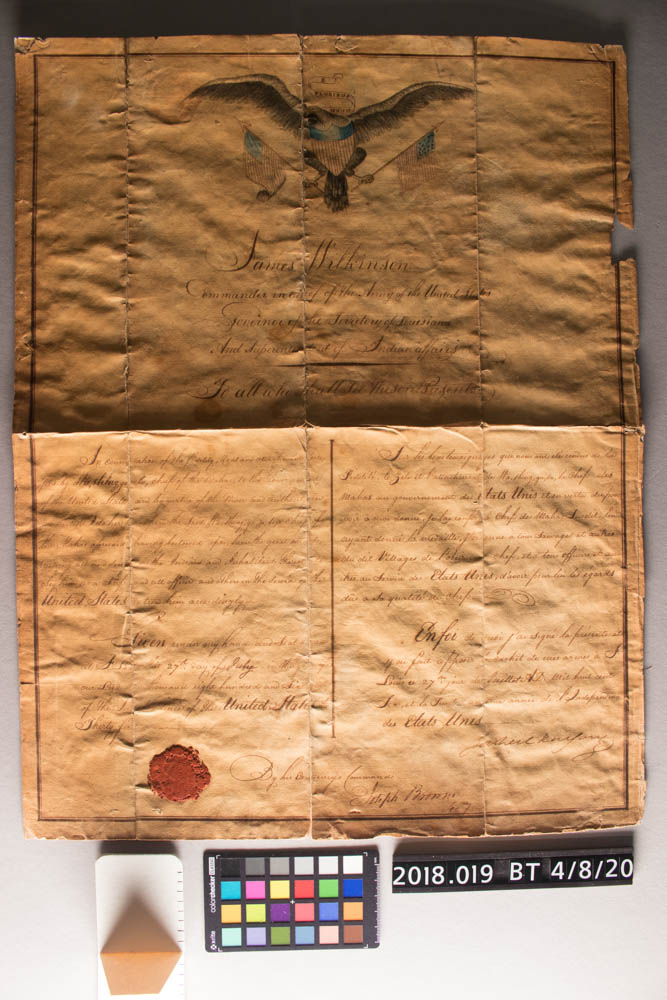When an artwork or artifact has been damaged through use or time, several terms get used, often interchangeably. Is the object going to be “preserved”, “restored,” or “conserved”? What is the difference and why does it matter? Let’s find out.
Preservation, also known as “preventive conservation” is the act of avoiding and minimizing future damage or deterioration. In order to preserve an item, it will be placed in protective housings, handled properly, and stored or displayed with proper environmental controls. Emergency planning, education, and even having an identifying number within a collection are all part of the preservation of an object.
Restoration takes place when an object is made to appear as it originally was. Restoration focuses primarily on the aesthetics or physical appearance of an object. This might involve filling losses, removing a discolored varnish or replacing a missing part. A restorer’s main concern is the look of the piece.
Conservation is a broader term that encompasses both preservation and restoration while also maintaining as much of the original object as possible. Any treatment is carefully documented. For example, if a table has a broken leg, a restorer might replace the leg altogether while a conservator would do their best to repair the leg and keep as much original material as possible. If the leg couldn’t be saved, it would be documented in photographs and a treatment report and the broken pieces likely kept with the table.
Conservators also strive to keep their treatments as reversible as possible. Retreatablility is important so that any work done on a piece can be undone if needed. It is easy for a work to be over-treated, as we will see in the following example, and sometimes when this happens, it can not be returned to its original state.

Before treatment photos of the two certificates, both of which were treated at different times in the past. This certificate was bleached resulting in an overly bright appearance.

This certificate was not bleached but was lined on an inappropriate material with an improper adhesive which might have contributed to the darkened color.
These two certificates were issued in on the same day in 1806 by James Wilkinson, Commander-in-Chief of the Army of the United States and then Governor of the Territory of Louisiana and Superintendent of Indian Affairs. The certificate on the left recognizes Chief Wash-Com-Ma-Ni of the “Maha” Tribe and the certificate on the left recognizes Chief Wa-Shng-Ga-Sa-Be of the “Maha” Tribe. The certificates are made of the same materials and were issued only months apart, but centuries later were treated differently.
Both certificates are in the collection of the Nebraska History Museum. They both exhibit tears and losses to the paper. They were folded at one time and creased. The certificate on the left was conserved previously when it was lined onto the heavyweight paper. It appears the certificate was washed and possibly bleached due to the very bright white color of the paper support. Some tears were misaligned when the piece was lined, and the ink has faded.


Before treatment photos of the two certificates. Here the certificates were photographed in raking light. Raking light means the light source is positioned at a low angle to highlight the surface distortions on a flat object.
The certificate on the right was previously lined onto a fabric lining. It is now delaminating from the lining and in some areas the lining is missing entirely. The paper support has darkened unevenly overall, and is particularly dark around the center. The overall dark discoloration appears to be the result of deteriorated adhesive from the lining. The paper has also become very brittle.
The certificate on the right was not washed so aggressively, if at all, but was lined onto an improper backing. Linings should be of a similar weight and material to the original piece. The adhesive used also likely contributed to the discoloration of the paper which will require more intervention to reduce the staining.
Both certificates are good examples of why conservators aim for minimal intervention in treatment and retreatability. By today’s standards, the certificate on the left has been overtreated. The paper was washed and bleached, resulting in an overly bright paper that is not in keeping with its original appearance or the object’s age and history of use. Bleaching also has the potential of weakening the paper fibers if used too aggressively.
Check back next month to see how these documents will be treated and stabilized for long-term preservation.
You can find more about the Ford Conservation Center HERE.



